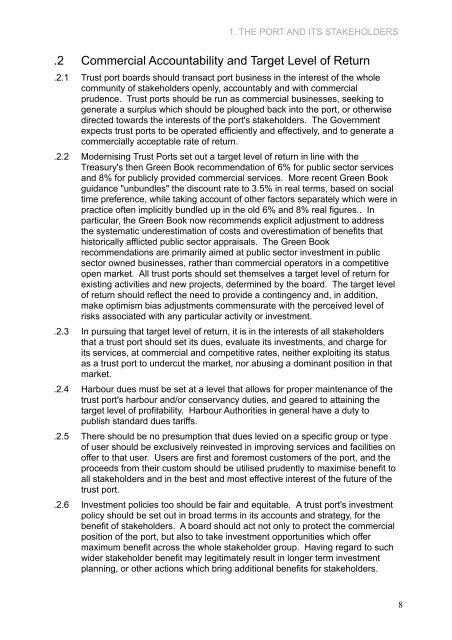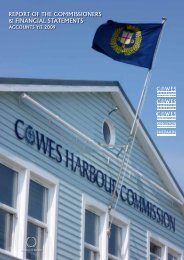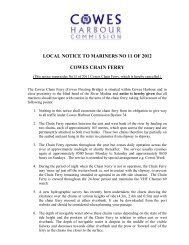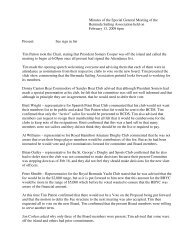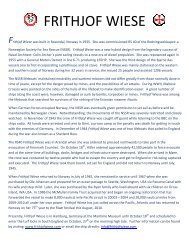Modernising Trust Ports 2nd Edition.pdf - SailingNetworks
Modernising Trust Ports 2nd Edition.pdf - SailingNetworks
Modernising Trust Ports 2nd Edition.pdf - SailingNetworks
Create successful ePaper yourself
Turn your PDF publications into a flip-book with our unique Google optimized e-Paper software.
1. THE PORT AND ITS STAKEHOLDERS.2 Commercial Accountability and Target Level of Return.2.1 <strong>Trust</strong> port boards should transact port business in the interest of the wholecommunity of stakeholders openly, accountably and with commercialprudence. <strong>Trust</strong> ports should be run as commercial businesses, seeking togenerate a surplus which should be ploughed back into the port, or otherwisedirected towards the interests of the port's stakeholders. The Governmentexpects trust ports to be operated efficiently and effectively, and to generate acommercially acceptable rate of return..2.2 <strong>Modernising</strong> <strong>Trust</strong> <strong>Ports</strong> set out a target level of return in line with theTreasury's then Green Book recommendation of 6% for public sector servicesand 8% for publicly provided commercial services. More recent Green Bookguidance "unbundles" the discount rate to 3.5% in real terms, based on socialtime preference, while taking account of other factors separately which were inpractice often implicitly bundled up in the old 6% and 8% real figures.. Inparticular, the Green Book now recommends explicit adjustment to addressthe systematic underestimation of costs and overestimation of benefits thathistorically afflicted public sector appraisals. The Green Bookrecommendations are primarily aimed at public sector investment in publicsector owned businesses, rather than commercial operators in a competitiveopen market. All trust ports should set themselves a target level of return forexisting activities and new projects, determined by the board. The target levelof return should reflect the need to provide a contingency and, in addition,make optimism bias adjustments commensurate with the perceived level ofrisks associated with any particular activity or investment..2.3 In pursuing that target level of return, it is in the interests of all stakeholdersthat a trust port should set its dues, evaluate its investments, and charge forits services, at commercial and competitive rates, neither exploiting its statusas a trust port to undercut the market, nor abusing a dominant position in thatmarket..2.4 Harbour dues must be set at a level that allows for proper maintenance of thetrust port's harbour and/or conservancy duties, and geared to attaining thetarget level of profitability. Harbour Authorities in general have a duty topublish standard dues tariffs..2.5 There should be no presumption that dues levied on a specific group or typeof user should be exclusively reinvested in improving services and facilities onoffer to that user. Users are first and foremost customers of the port, and theproceeds from their custom should be utilised prudently to maximise benefit toall stakeholders and in the best and most effective interest of the future of thetrust port..2.6 Investment policies too should be fair and equitable. A trust port's investmentpolicy should be set out in broad terms in its accounts and strategy, for thebenefit of stakeholders. A board should act not only to protect the commercialposition of the port, but also to take investment opportunities which offermaximum benefit across the whole stakeholder group. Having regard to suchwider stakeholder benefit may legitimately result in longer term investmentplanning, or other actions which bring additional benefits for stakeholders.8


